Their first game was against fellow expansion brothers the Pirates in Pittsburgh in a contest won by the Americans 2-1 in overtime. Future Hockey Hall of Famer and team captain Billy Burch scored the first goal in team history at 6:12 of the second period, assisted by veteran Ken Randall. Pittsburgh evened the score at 9:45 on a goal by the great Lionel Conacher, who would play a role in Americans team history later on. The third period went by with no scoring, sending the game into an extra period where defenseman Charlie Langlois won the game for New York with an unassisted, short-handed goal at 3:10 to get the franchise off to a fine start.
After four road games to start the season, the Americans would finally play their first game in their new home, which was not originally designed with the ability to create a sheet of ice.
Madison Square Garden in 1925
Duggan arranged for Madison Square Garden owner Tex Rickard to come to Montreal with Dwyer, who would arrange to properly lubricate Tex with some of his underground liquor production before the Canadiens game he was about to witness. The sight of the sold out arena, combined with the dazzling display put on by Canadiens star Howie Morenz suitably impressed Rickard, who agreed to modify the plans for Madison Square Garden to include ice making capabilities on the condition that Morenz be present for opening game. Thus the first opponent hosted by the Americans was none other than Morenz and the Canadiens, who defeated the home team by a score of 3-1 in front of 17,422 curious New Yorkers who saw Morenz seal the victory for Montreal with their third goal at 4:15 of the third period.
A program from the Americans first season
Despite stocking their roster with the players from the first place Tigers club, the team finished fifth out of seven with a 12-20-4 record, led by Burch in scoring with 22 goals, quite nearly one-third of the team's total of 68, and 25 points.
The 1925-26 New York Americans
Still, despite the placing in the standings, the Americans season overall was deemed such a success at the gate that Rickard obtained his own NHL franchise for the 1926-27 season, which would be nicknamed Tex's Rangers. With the addition of not only a second team in Madison Square Garden, but also Chicago and Detroit joining the league, the NHL was split into two divisions, with the Americans being placed in... the Canadian Division! The extra travel over the border took it's toll on the club and they once more finished out of the playoffs with a 17-25-2 record. Burch again led he club in scoring with 19 goals and 27 points, ten more than Conacher, who was obtained from the cash strapped Pirates.
The Americans sank to last in the Canadian Division in 1927-28 with just 11 wins in the face of 27 losses and 6 ties. To make matters worse, the New York Rangers, owned by their landlord Rickard, won the Stanley Cup in only their second year of existence! From the beginning of the two clubs competing for the same fan base. The Rangers, who were coached by the elegant and respected Lester Patrick, became the team of choice for the upper class of Manhattan while the Americans, perhaps tainted by being associated the jailed bootlegger Dwyer, who was arrested 11 days before the Americans first game and spent the entire first season locked up, were the "working class" team, who somehow failed to capture the imagination of the fanbase in the same manner as the stylish and immediately successful Rangers.
Goaltender
Roy Worters was obtained from Pittsburgh to solidify the Americans defense, and the club responded with their first winning record, finishing 19-13-12 for second place in their division and their first playoff berth - against their rival Rangers, who won the two-game, total-goals series 1-0 on a dramatic goal at 29:50 of overtime of the second game. Burch led the club in scoring for the third time in four seasons and Worters was named the
Hart Trophy winner as league MVP.
The 1928-29 New York Americans
The team plunged to fifth place in the 1929-30 season under new head coach Conacher and missed the postseason for what would be the first of six consecutive seasons. Norman Himes, who led the team in scoring in 1928, set a new club records with 28 goals and 50 points, breaking Burch's mark of 36.
Himes again led the club in scoring in 1931-32, although he came back down to Earth with just 24 points. While the Americans finished "fourth" in the Canadian Division, it was due to attrition, as the Ottawa Senators had not competed that season due to financial difficulties, which meant the Americans actually came in last and missed out on the playoffs for the third season in a row. Additionally, the Pirates had by now moved to Philadelphia for a single, dismal 4 win season and closed up shop for good, unable to survive the Great Depression.
The 1932-33 Americans were led in scoring by Himes for the fourth consecutive season as Worters continued to hold down the duties in goal while their won/loss record continued to slip, now down to 15-22-11, a mark essentially duplicated in 1933-34 at 15-23-10. Eddie Burke led the club offensively with 20 goals and 30 points in 46 games. In hockey sweater news, the Americans introduced a second, white sweater, making them only the second team to have two styles following Toronto in 1927. The struggling team attempted a merger at this point with the equally poor Ottawa Senators, which was turned down by the NHL Board of Governors.
The club had a difficult time in 1934-35 with just 12 wins and their sixth straight, and ninth out of ten seasons of their existence, with no playoffs. Meanwhile, the Rangers not only had yet to have a losing season, made the playoffs in every single one of their now nine seasons and had also delivered a second Stanley Cup by then, which had arrived in 1933.
Another issue for the "Amerks" was Dwyer's inability to recognize the benefits of stability. The club literally had a different head coach every season for their first six seasons, as Tommy Gorman, Newsy Lalonde, Shorty Green, Gorman again, Lionel Conacher and Eddie Gerard all took turns behind the bench until Gerard managed to hold onto the job for two seasons in a row, but only two seasons, as Bullet Joe Simpson then took the helm for three seasons, 1932-33 to 1934-35. Meanwhile, Patrick remained behind the bench for the Rangers' first 13 seasons, and won while doing it, winning 281 games while the Americans would only manged to win 255 during their entire 17 years.
The world turned upside down in 1935-36, as not only did Sweeney Schriner lead both the Americans and the NHL in scoring, but the Americans finally returned to the postseason guided by new head coach and general manager Red Dutton, while the Rangers missed out on the playoffs for the first time in their history! Oddly enough, the Rangers kept their streak of winning records intact at 19-17-12, while the Americans streak of losing records continued for the fifth straight season but it was enough for the Americans to finish third in the Canadian Division to advance to the postseason. They made the most of the opportunity, and defeated the Chicago Black Hawks 3-0 before staying close enough in a 5-4 loss in Game 2 to win their first ever playoff series 7-5 in total goals. Round 2 went to Toronto, who won the best-of-three 2 games to 1.
NHL scoring champion Sweeney Schriner
On the business side of the operation, owner Dwyer, now finding it difficult to pay the bills with the end of prohibition, saw the club taken over by the league. Dwyer was given a second chance, but could not pay off his debts and the league took full control for the 1937-38 season.
After 1936-37, which saw the Americans out of the playoffs once again following a 15-29-4 mark in Worters ninth and final season in goal for the Americans, the club posted only the third winning season in their history when they won 19, lost 18 and tied 11 thanks to Dutton acquiring veterans Ching Johnson and Hap Day.
Ching Johnson
Schriener again led the team in scoring with 21 goals and 8 points and the Americans finally got the best of the Rangers, knocking them out of the playoffs in a hard fought Round 1, winning 2-1 in overtime of Game 1, losing 4-3 in Game 2 before winning Game 3 by a score of 3-2 "on the road" at Madison Square Garden in an epic four overtimes in what was then the fourth longest game in league history and arguably the highlight of the Americans franchise history. Despite winning Game 1 of Round 2 versus Chicago, the Black Hawks rebounded with two straight wins to eliminate the Americans.
The Americans qualified for the postseason with a losing record once more at 17-21-10 thanks to the demise of the Montreal Maroons leaving the NHL as one seven team division, with the top six qualifying for the playoffs. Schriner led the team in scoring for the fourth consecutive season with 44 points but a quick exit from the playoffs followed, as they failed to score a goal in either game against the Maple Leafs.
Financial troubles led to Schriner departing for Toronto in exchange for four players. Also of note, the club acquired the great defenseman Eddie Shore late in the season from Boston. The now 37 year old Shore played the final ten games of his career, as well as three playoffs games, as the Americans scrapped their way to a sixth place finish, with their 15-29-4 record surpassing the Canadiens, who won only 10 times. The Americans drew the Detroit Red Wings, who defeated them 2 games to 1 to end Shore's career. Meanwhile, the Rangers captured their third Stanley Cup, while the Americans had yet to win three playoff series.
Eddie Shore during his brief time with the Americans
The Americans hit bottom in 1940-41 after being forced to sell of their best players in an attempt to stay solvent, coming in a distant last with a dismal 8-29-11 record, the only team to score less than 100 goals and the only to allow more than 147, with 186 against.
Desperate to improve their financial situation, the club changed it's name for the 1941-42 season to the Brooklyn Americans in hopes of connecting with the fans across the East River in Brooklyn despite retaining Madison Square Garden in Manhattan as their home arena due to the lack of a suitable arena in Brooklyn. The team improved record-wise to 16-29-3, but despite scoring 34 more goals while allowing 11 less and improving 8 points in the standings, the Americans finished last in the NHL and missed out on the playoffs once again.
With the arrival of World War II, the Americans were hit harder than most due to their already weak financial position. With many players off to serve in the war, combined with travel restrictions and Dutton's inability to actually relocate the team to Brooklyn, the team suspended operations with the intent of regrouping and coming back after the war. Despite an effort to build a new arena in Brooklyn as a home for the team in 1945, the NHL finally cancelled the franchise formally in 1946.
In all, the Americans played 17 seasons, qualifying for the playoffs just five times despite only three winning records in their history.
With the New York Islanders first official game in Brooklyn tonight at their new home, the Barclays Center, The Brooklyn Historical Society is now hosting an exhibit titled: "
Brooklyn Americans: Hockey's Forgotten Promise".
The exhibit, which opened on September 23rd will be on display through March 27, 2016, features programs from the 1920's and 1930's, team photos, scrapbooks and other memorabilia, including
Chuck Rayner's goalie stick, Worters' skates, a sweater worn by GM Dutton and
Pat Egan's warmup jacket. The gallery will be open Wednesday through Sunday from noon to 5 PM and is located at 128 Pierrepont Street in Brooklyn at the corner of Clinton Street in Brooklyn Heights.
It also features original footage of the team in action and recorded interviews with former Brooklynites who either played or were fans of hockey in Brooklyn.
The Brooklyn Americans exhibit at the Brooklyn Historical Society
photo ©Scott Rudd
"With the imminent arrival of the New York Islanders in the borough, we are thrilled to be uncovering the history of hockey in Brooklyn," said
Deborah Schwartz, President of the Brooklyn Historical Society. "We hope that visitors not only walk away with a new understanding of hockey history, but also a better appreciation of how far Brooklyn has come."
Today's featured jersey is a
1941-42 Brooklyn Americans Tom Anderson jersey as worn by defenseman and recently converted left winger Anderson during the Americans final season. Anderson was named the winner of the Hart Trophy as league MVP after setting a league scoring record for defensemen with 41 points in 48 games. He played eight NHL seasons, with his MVP season being his last, as military duty brought his NHL career to a premature end. He remains one of three Hart Trophy winners not elected into the Hockey Hall of Fame.
The Americans adopted their first white jersey, complete with red stripes down the arms and red cuffs, back in 1933. There would be frequent changes in the cresting and waist stripe colors and thickness until the desperate name change to "Brooklyn" in 1941, despite the team never actually playing in Brooklyn.
This game worn example no longer has it's original number 7 on the back, but it's outline is still clearly visible on the back, thanks in part to the bleeding of the dye of the red digit's blue outline.
Bonus jersey: Today's bonus jersey is a
1925-26 New York Americans Billy Burch jersey as worn during the Americans inaugural season. When the Americans took to the ice, it was in their new, star-spangled sweaters, unlike any seen before in the NHL, and we dare say ever since, thanks to it's more than three dozen stars.
The Americans first wore their star spangled sweaters for all games during their first eight seasons, either home or road, before adding a white alternate jersey in 1933. They would wear both jerseys through the 1937-38 season, which was the last for the original stars and stripes jersey. For their final four seasons, only the white jerseys were worn for all games.
Today's video is a look at the history of the New York Americans.

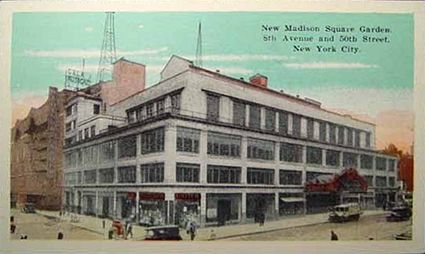
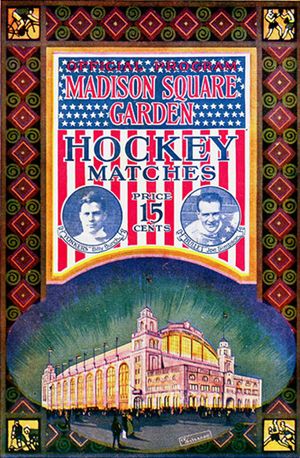
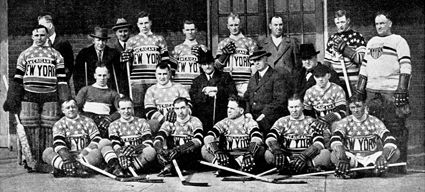
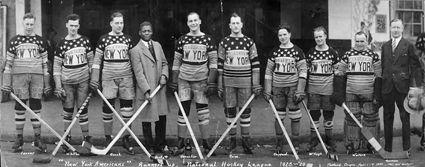
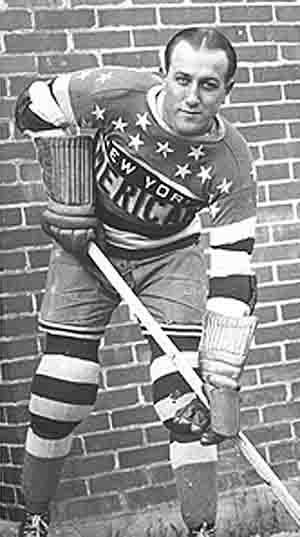
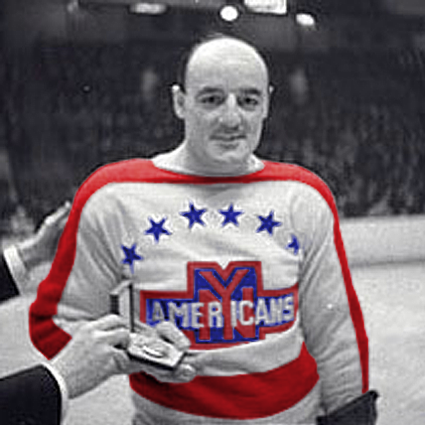
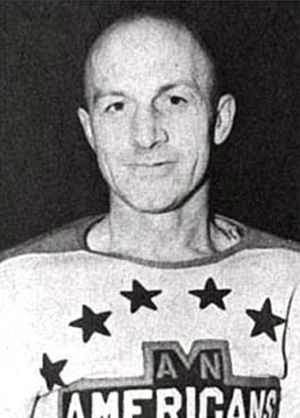
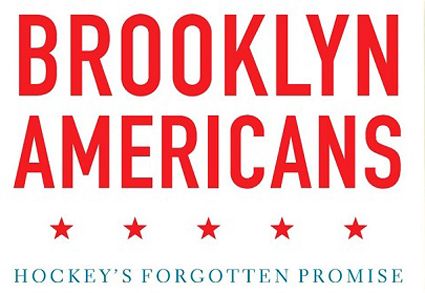
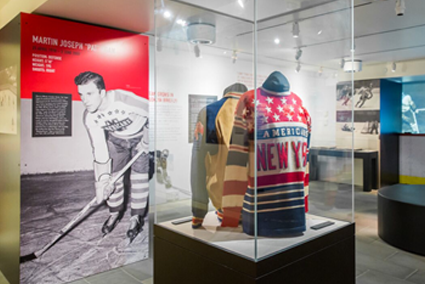
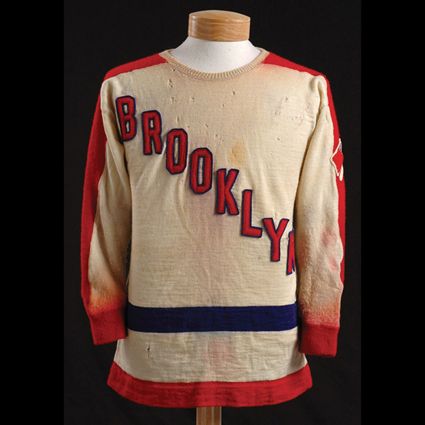
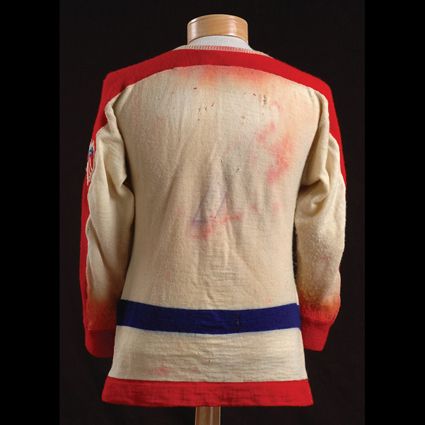
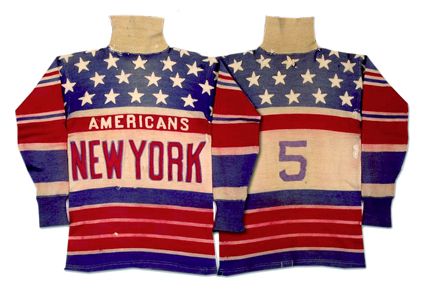
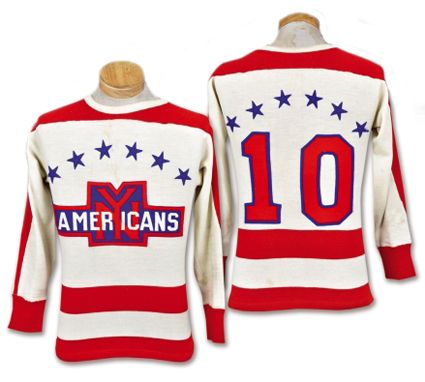










No comments:
Post a Comment
We welcome and encourage genuine comments and corrections from our readers. Please no spam. It will not be approved and never seen.